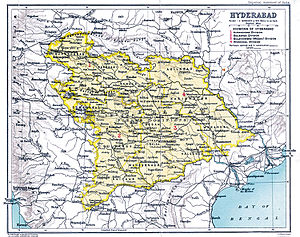Pandit Sunderlal Committee Report
| Operation Polo | |||||||
|---|---|---|---|---|---|---|---|
 The State of Hyderabad in 1909 (excluding Berar). |
|||||||
|
|||||||
| Belligerents | |||||||
|
|
|
||||||
| Commanders and leaders | |||||||
|
|
|
||||||
| Strength | |||||||
| 35,000 Indian Armed Forces | 22,000 Hyderabad State Forces est. 200,000 Razakars (Irregular forces) |
||||||
| Casualties and losses | |||||||
| 32 killed 97 wounded |
Hyderabad State Forces: 807 killed unknown wounded 1,647 POWs Razakars: 1,373 killed 1,911 captured |
||||||
| official: 27,000 – 40,000 civilians killed responsible observers: 200,000 civilians killed |
|||||||
Decisive Indian victory
Operation Polo is the code name of the Hyderabad "police action" in September 1948, by the newly independent India against the Hyderabad State. It was a military operation in which the Indian Armed Forces invaded the Nizam-ruled princely state, annexing it into the Indian Union.
At the time of Partition in 1947, the princely states of India, who in principle had self-government within their own territories, were subject to subsidiary alliances with the British, giving them control of their external relations. In the Indian Independence Act 1947 the British abandoned all such alliances, leaving the states with the option of opting for full independence. However, by 1948 almost all had acceded to either India or Pakistan. One major exception was that of the wealthiest and most powerful principality, Hyderabad, where the Nizam, Osman Ali Khan, Asif Jah VII, a Muslim ruler who presided over a largely Hindu population, chose independence and hoped to maintain this with an irregular army recruited from the Muslim aristocracy, known as the Razakars. The Nizam was also beset by the Telangana uprising, which he was unable to subjugate.
The Indian government, anxious to avoid what it termed a Balkanization of what had been the Indian Empire, was determined to effect the integration of Hyderabad into the new Indian Union. Amidst atrocities by the Razakars, the Indian Home Minister Sardar Patel decided to annex Hyderabad in what was termed a "police action". The operation itself took five days, in which the Razakars and the Hyderabadi Military were defeated swiftly.
The operation led to massive violence on communal lines. The Indian prime minister Jawaharlal Nehru appointed a commission known as the Sunderlal Committee. Its report, which was not released until 2013, concluded that "as a conservative estimate...27,000 to 40,000 people had lost their lives during and after the police action." Other responsible observers estimated the number of deaths to be 200,000 or higher.
...
Wikipedia
